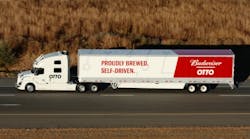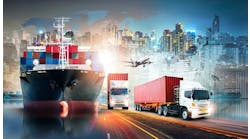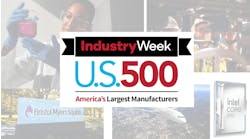No matter what products they make, how many they make, or how often they make them, all U.S. manufacturers share a common goal: They need to get their products to their customers, on time, and the familiar litany of trucks-trains-boats-and-planes (and sometimes, pipelines) remains the way that goods get moved. At least that’s the case in early 2017. Within a year or two, maybe not so much.
Thanks to the rise of e-commerce, which has up-ended the delivery expectations of virtually every product-centric industry, manufacturers now live in the same environment that their retail customers have long toiled in—the world of “get it to me now, or I’ll take my business elsewhere.” While to some extent companies have always had to accommodate the often-unreasonable demands of their customers, transportation technology has finally arrived to meet at least some of that demand.
Executives at the big trucking companies can already read the tea leaves, and recognize that business-as-usual no longer applies. “The transportation of information is more important than the transportation of goods,” offers James Welch, CEO of YRC Worldwide Inc., one of the largest national less-than-truckload (LTL) carriers. Adds Jon Russell, president of Celadon Logistics, a division of truckload carrier Celadon, “If you’re not investing in technology and constantly reinventing yourself, you’re not going to be around very long.”
“We are getting to the point that, in the not-too-distant future, through vehicle-to-vehicle and vehicle-to-infrastructure technologies and sensors and the ability to detect where things are, every vehicle will know where every other vehicle is, as well as where they are in relationship to the fixed environment they’re moving in,” observes Scott Corwin, managing director with Deloitte Consulting and leader of Deloitte’s Future of Mobility initiative.
Indeed, connected highways powered by Internet of Things-enabled sensors are currently being tested on a limited basis on various U.S. highways, primarily in controlled pilots to determine the viability of driverless trucks. The State of Ohio, for instance, is investing $15 million in a 35-mile Smart Mobility Corridor to test IoT and autonomous vehicle technology.
Meanwhile, some companies have figured out a way to circumvent the whole issue by eliminating goods transportation entirely. These would be the companies who have disintermediated the traditional distribution channels in favor of the Internet and the cloud. Apple, for instance, a manufacturer of physical electronic gadgets like tablets and smartphones, also reportedly makes $1 billion or so per year by selling digital downloads of recorded music and other products through its iTunes store. That model, though, has already neared its expiration date thanks to the emergence of companies like Spotify and Pandora, whose own distribution models rely on users streaming rather than downloading music.
But when it comes to physical goods distribution, retail giant Amazon has emerged as perhaps the single most influential driver of new logistics technologies. Whether it’s pioneering warehouse robots, delivery drones, self-driving trucks, or even the very networks that would coordinate autonomous vehicles, Amazon has made it clear that it will leave no product undeliverable, no matter where it might be made or where it needs to go. And many other companies—whether traditional trucking and delivery firms with their own fleets or technology startups whose main asset is a smartphone app—will have plenty to say about the next generation of transportation technology as well.
Who’s Behind the Wheel? Nobody
According to a recent White House study (the Obama Administration, that is, not the Trump Administration), the traditional role of the long-haul truck driver could very well end up being replaced by autopilot technology. True, all studies of autonomous trucks acknowledge that a human being will have to be in the cabin of the vehicle in case the situation warrants, but nevertheless, the study—“Artificial Intelligence, Automation and the Economy” —indicates that as many as 1.7 million drivers could be, at the very least, nudged over to the passenger side of the cabin in favor of a self-driving computer that never gets sleepy and never needs a rest stop. The study, however, stops short of offering a timeline for when these autonomous vehicles will begin appearing on the highways.
It’s not necessarily technology—or the lack of it—that’s keeping humans behind the wheel for now. Regulatory hurdles could be just as tricky to maneuver. But according to Scott Perry, chief technology and procurement officer for Ryder System Inc., a commercial fleet management and dedicated transportation provider, the regulatory environment could end up helping to drive significant advancements in the area of autonomous vehicles. For instance, the mandated reductions in greenhouse gas emissions is leading to breakthroughs in automated manual transmission—technology that shifts automatically, resulting in better fuel economy and an easier operation for the driver, Perry points out.
And there’s a compelling argument to make that having nobody behind the wheel is safer than having a driver: 94% of all highway accidents are caused by human error, according to the Transportation Department’s National Highway Traffic Safety Administration (NHTSA). In December 2016, the NHTSA proposed a rule mandating the deployment of connected vehicle-to-vehicle (V2V) communication technology. What’s more, the agency also plans to issue guidance for vehicle-to-infrastructure (V2I) communications, the type of Internet-of-Things technologies that allow highway vehicles to “talk” to traffic signals, construction displays, variable speed limit signs and other digital displays.
Semi-autonomous vehicle technologies also offer a potential solution to the shortage of truck drivers, Perry adds. “Many drivers have recently retired from the industry, but these advanced technologies may actually extend the careers of aging drivers and attract even more candidates to the industry, including women.”
Anheuser-Busch, one of the largest beer producers in the world, is one manufacturer eager to explore the potential of autonomous vehicles and intelligent highways. The beverage giant recently partnered with Otto, Uber’s self-driving vehicle division, to put a new spin on the idea of a beer run. The two companies teamed up last fall to pilot test a delivery of Budweiser using one of Otto’s self-driving tractors, pulling a 53-foot truckload of beer. Although a human was on-board to monitor the process, he remained in the sleeper berth of the cabin.
The truck traveled roughly 120 miles on a stretch of Interstate 25 from Fort Collins, Colo., through the Denver metropolitan area to Colorado Springs. It’s believed to be the first commercial transport of freight via a self-driving vehicle (the trip wasn’t entirely autonomous, as a human drove the truck from its origination at an Anheuser-Busch plant in Loveland to an I-25 on-ramp, and completed the delivery to its final destination once the truck exited the interstate).
“As we continue to partner with long-haul carriers to ship our beers, we hope to see self-driving technology widely deployed across our highways to improve safety for all road users and work towards a low-emissions future,” says James Sembrot, senior director of logistics strategy with Anheuser-Busch.
The “Uberization” of Trucking
One of the trends most keenly being followed by transportation managers at manufacturing companies both large and small is the so-called “Uberization” of trucking. Just as Uber has turned the traditional ride-hailing industry dominated by taxi cab companies on its head by allowing individuals to arrange for a passenger vehicle through a smartphone app, so too, the logic follows, it should be possible for companies to contract with freight-hauling trucking firms through the same type of app. And there are already plenty of developers hard at work on that type of app.
In December 2016, Business Insider reported that Amazon was developing an app that would match truck drivers with shippers, and that the online retailer planned to launch the app sometime this summer. The goal, according to the report, is to make it easier for drivers (presumably independent owner-operators, rather than fleet operators) to find companies that needed freight moved. Such an app would effectively squeeze out the need for using a freight broker and paying a commission for the service. The app, which at this writing Amazon hasn’t officially announced, might also include real-time pricing and delivery instructions, as well as pick-up and delivery directions.
Other companies competing in the “freight hauling app” category include Cargo Chief, Cargomatic, Convoy, Fleet, Haulme, Transfix ,TruckerPath, XYpper and probably a dozen more (including Uber itself), as the space is particularly ripe with startups hoping for just a fragment of a marketplace that theoretically could be worth nearly a trillion dollars (the amount spent on freight transportation in the U.S. last year was $890 billion), or could be worth next-to-nothing if the idea fails to catch on.
In any event, despite the rush to develop technology that can match freightloads with available drivers, one huge obstacle stands in the way: the nature of the freight itself.
“One of the key components of Uber’s model is the commodity-like nature of the ride-hailing service,” notes Evan Armstrong with Armstrong & Associates, a consulting firm focused on third-party logistics. The principle behind digital freight matching is relatively simple, as it involves the use of a digital platform (or app) to match a manufacturer’s freight with available transportation provider capacity. However, while the Uber model works for passengers who typically want to be transported short distances in a single metropolitan area, domestic transportation is far more complicated than that.
For instance, Armstrong points out, complexities arise in the form of specialized equipment types (such as flatbed, refrigerated, or hazmat]; shipments transported via multiple modes (such as from ocean carrier to railcar to truck); and necessary exception handling for service issues (such as equipment breakdowns or weather-related incidents). “Shipments are high-value and time-sensitive,” he adds, “so placing an Uber-like app atop a complex industry doesn’t truly address the problem.”
John Wiehoff, chairman, CEO and president of C.H. Robinson Worldwide Inc., one of the country’s largest third-party logistics providers (3PLs), agrees. “The commoditization of freight is a lot different than that of raw materials or even taxi passengers due to all of the exceptions and requirements of picking up and delivering a load,” he points out.
As a 3PL, C.H. Robinson does not own any of its own trucks or other vehicles, but contracts with transportation carriers of all types—trucks, rail, air and ocean—on behalf of its customers, which include top-tier manufacturers such as Coca-Cola, Becton, Dickinson & Co., Ocean Spray, ConAgra and Newell Brands. “Virtually every transportation mode we offer is being changed by the demands of e-commerce, which is the number one most disruptive change to our business,” Wiehoff says.




